The akiro Blog

Category Manager Salary Insights in the United States 2025
Get the latest 2025 insights into category manager salaries across the US; role levels, regional trends, and how to leverage data for talent strategy.

Hiring or retaining top procurement talent in 2025?
Understanding category manager salary benchmarks is critical. With supply chain complexity rising and category strategy gaining boardroom attention, the competition for experienced category managers is intensifying. Yet, many executives still rely on outdated compensation data, putting both recruitment and retention at risk.
This article breaks down the latest insights on category manager salary trends in the United States, including role variations, geographic factors, experience-based pay, and market outlook.
National Salary Averages & Ranges for Category Managers
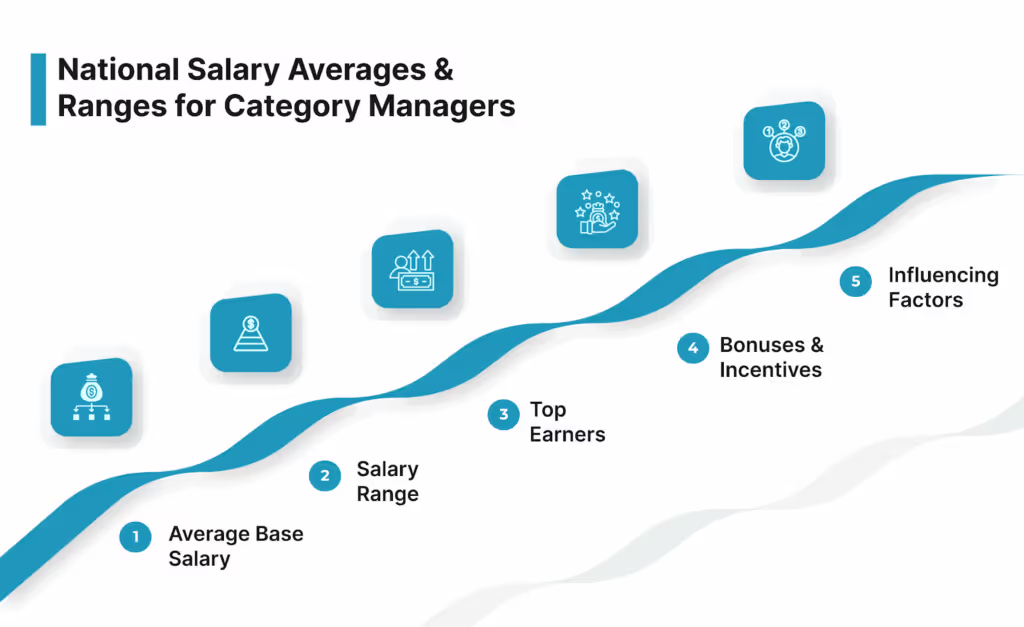
Understanding national benchmarks for category manager salary gives you a strong foundation for building competitive compensation packages. In 2025, salaries vary widely based on factors like company size, location, and experience level, but some clear national trends are emerging.
- Average Base Salary: As per Indeed, the national average salary for a category manager in the United States is approximately $99,074 per year.
- Salary Range: Reported salaries typically fall between $80,000 and $130,000, depending on the industry and region.
- Top Earners: Senior category managers or those working in high-cost metros (like NYC or San Francisco) can earn upwards of $145,000 annually.
- Bonuses & Incentives: Annual bonuses and performance-based incentives can add an additional 10–20% to total compensation.
- Influencing Factors: Education, certifications (like CPSM or CIPS), and tech stack experience (especially with AI-driven procurement tools) can significantly boost salary.
Let’s now explore how the category manager salary shifts based on role variations and specialization levels.
Role Variations & Compensation Levels for Category Managers

Not all category managers perform the same functions or earn the same salary. Your compensation often reflects the complexity of your responsibilities, the size of your team, and the strategic value you bring to the organization.
- Associate/Junior Category Manager: Typically earns between $65,000–$85,000, with limited strategic responsibility and more focus on support and data analysis.
- Mid-Level Category Manager: Falls in the range of $90,000–$110,000, managing categories independently and leading sourcing initiatives.
- Senior Category Manager: Commands between $115,000–$140,000, often handling high-spend categories and overseeing supplier negotiations, contracts, and performance.
- Global/Strategic Category Manager: Salaries range from $135,000 to $160,000+, particularly in multinational firms. These roles influence enterprise-wide procurement strategy and supplier relationships.
- Category Director or Head of Category Management: Can earn over $180,000, including bonuses and equity, with responsibility for multi-category portfolios, teams, and transformation projects.
Next, let’s examine how geography impacts your earning potential across different states and cities.
Geographic Impacts on Category Manager Salary in the US
Where you work plays a major role in how much you earn. Location influences not just your base pay, but also bonus potential, cost of living adjustments, and market demand for procurement expertise.
- California (esp. San Francisco & Los Angeles): Category managers here earn an average of $125,000–$150,000, driven by high cost of living and demand in tech and retail sectors.
- New York (esp. NYC): Salaries typically range from $120,000–$145,000, with financial services and global supply chains pushing compensation higher.
- Texas (Austin, Dallas, Houston): Averages hover around $105,000–$125,000, with growing opportunities in energy, healthcare, and logistics.
- Illinois (Chicago): Expect to see ranges between $100,000–$120,000, with strong demand from manufacturing and CPG companies.
- North Carolina (Charlotte, Raleigh): Salaries fall between $95,000–$115,000, reflecting a lower cost of living and growing tech presence.
- Remote Roles: National companies hiring remote category managers often offer competitive packages adjusted to market benchmarks rather than your zip code.
Let’s now explore how your career stage and years of experience shape your earning trajectory.
Career Stage & Experience Curve: How Your Role Evolves Over Time
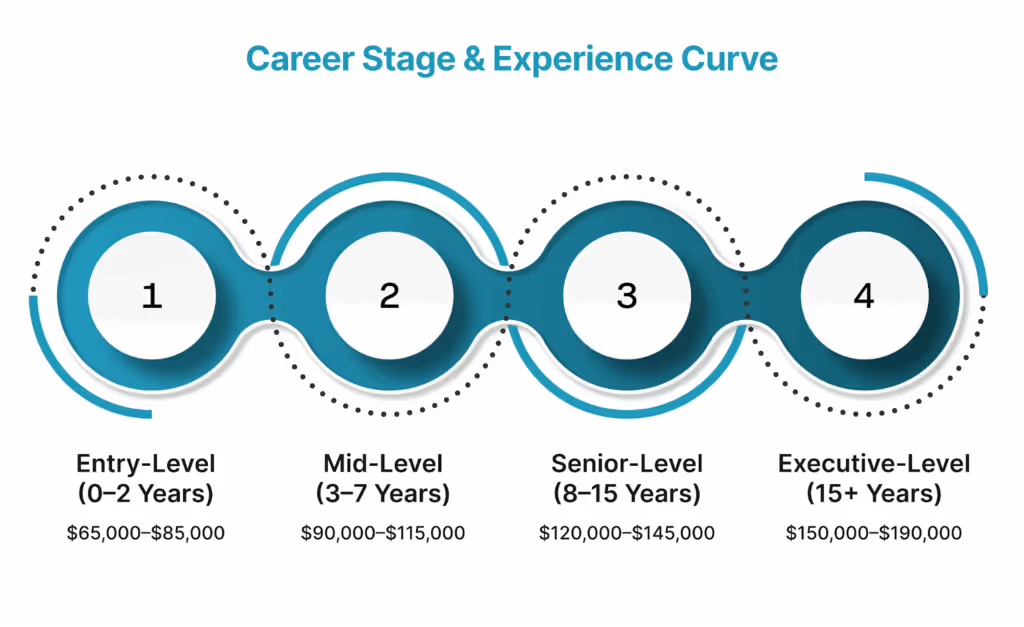
As a category manager, your salary typically scales with experience, skill depth, and strategic responsibility. Understanding the experience curve helps you benchmark your current earnings and plan your next move.
- Entry-Level (0–2 Years): You’re likely starting as a junior category analyst or coordinator. The average salary sits between $65,000–$85,000, depending on industry and location. Expect to focus on tactical sourcing, data gathering, and supplier support.
- Mid-Level (3–7 Years): At this stage, your title likely advances to category manager. You’ll earn anywhere from $90,000–$115,000, taking on vendor negotiations, budget ownership, and category strategy input.
- Senior-Level (8–15 Years): With more strategic influence, you could move into roles like senior category manager or procurement lead. Compensation ranges from $120,000–$145,000, including bonuses. You drive cost optimization, category planning, and cross-functional leadership.
- Executive-Level (15+ Years): Roles such as Director of Procurement or VP of Sourcing command salaries upward of $150,000–$190,000, especially in enterprise or multinational firms. Strategic oversight, supplier governance, and transformation initiatives become core responsibilities.
Now let’s break down the factors that most significantly influence these compensation levels.
Key Compensation Drivers: What Influences Your Salary
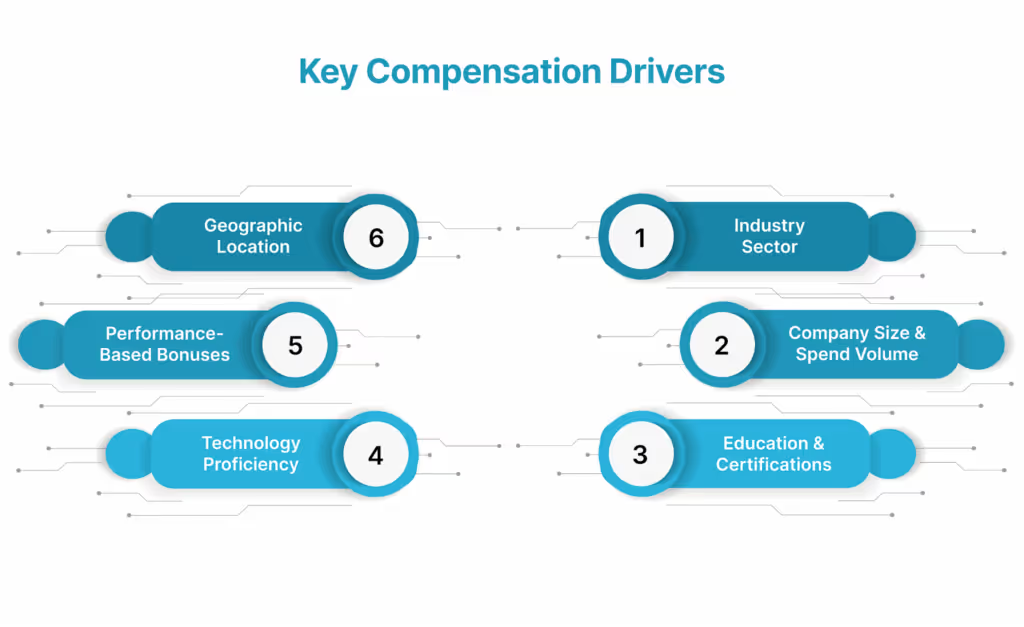
Understanding what drives your salary can help you make smarter career decisions, negotiate more confidently, and position yourself for growth. Several variables impact what you earn as a category manager, beyond just years of experience.
- Industry Sector: Salaries tend to be higher in industries like pharmaceuticals, technology, and manufacturing, where procurement complexity and spend volumes are greater.
- Company Size & Spend Volume: Larger enterprises with global supply chains typically offer higher compensation due to increased scope, risk, and strategic influence.
- Education & Certifications: Holding an MBA, CPSM, or CIPS certification can boost your earning potential significantly, some employers pay 10–15% more for certified professionals.
- Technology Proficiency: Familiarity with tools like SAP Ariba, Coupa, and AI-powered procurement platforms is increasingly a differentiator. Data-savvy professionals often command higher salaries.
- Performance-Based Bonuses: In many organizations, a sizable portion of compensation is tied to KPIs like cost savings delivered, contract cycle times, and supplier performance scores.
- Geographic Location: Urban centers and regions with high cost-of-living indices, like New York, San Francisco, or Boston, tend to offer higher base salaries.
As demand grows for skilled procurement leaders, it’s critical to stay ahead of evolving trends in the job market.
Actionable Advice: Optimizing Category Manager Compensation Strategy
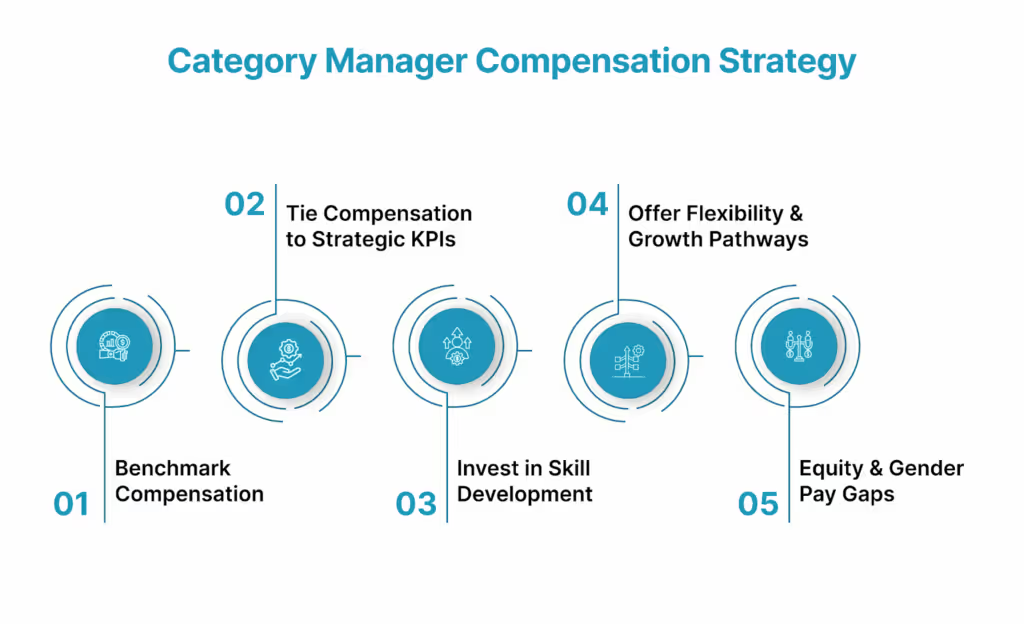
To attract and retain top category management talent, you need more than competitive salaries, you need a strategy. Whether you're scaling procurement operations or refining compensation models, aligning talent investment with business value is key.
- Benchmark Compensation Regularly: Use up-to-date salary data from credible sources like Glassdoor, Salary.com, and ZipRecruiter to stay competitive in your industry and region.
- Tie Compensation to Strategic KPIs: Structure bonuses or incentives around cost savings, supplier innovation, risk mitigation, or ESG targets to drive high-impact performance.
- Invest in Skill Development: Support certifications (e.g., CPSM, CIPS), training in data analytics, or AI procurement tools to future-proof your talent pool and justify higher salaries.
- Offer Flexibility and Growth Pathways: Hybrid work options, leadership opportunities, and cross-functional exposure can elevate your EVP (employee value proposition) beyond base pay.
- Evaluate Equity and Gender Pay Gaps: Conduct internal audits to identify and close compensation gaps across categories, locations, and diverse talent pools.
Understanding these strategies positions you to compete in an evolving procurement talent market, where demand outpaces supply.
Conclusion
Understanding the dynamics behind category manager salary trends isn't just a matter of compensation but a strategic advantage. As businesses compete for top procurement talent, aligning salary structures with role complexity, geography, and performance expectations becomes critical. You now have the insights to benchmark effectively, set competitive pay scales, and empower your category teams with clarity and purpose.
But insight alone isn't enough, you need the right tools to act on it.
With our AI-powered platform, you can link salary data to strategic performance, optimize team structures, and ensure your category managers deliver maximum value.
Ready to make smarter talent and category strategy decisions? Book a personalized demo with akirolabs and elevate your procurement leadership today.

Top 10 Common Procurement Challenges and How to Overcome Them
Overcome procurement challenges today with strategic solutions. Improve data accuracy, manage supply risks, and adopt technology. Click now to streamline your buying process!

Procurement plays a pivotal role in the success of any organization, ensuring the efficient acquisition of goods and services that drive daily operations and strategic goals. However, this critical function is not without its challenges. From navigating supplier relationships and managing costs to ensuring compliance with ever-evolving regulations, procurement professionals often juggle many complex tasks.
A recent survey highlights the prevalence of these challenges, with over 55% of organizations reporting difficulties in sourcing reliable suppliers. Additionally, issues such as managing supplier risks, adapting to market fluctuations and implementing technology effectively further complicate the procurement landscape.
Understanding and addressing these obstacles is crucial for transforming procurement into a value-driven process that enhances operational efficiency and resilience. By employing strategic approaches and innovative tools, businesses can tackle these challenges and turn them into opportunities for growth and competitive advantage.
What Do You Understand About Procurement Challenges?

Procurement challenges are obstacles to acquiring the goods, services, or resources essential to your organization’s operations. These issues stem from internal inefficiencies, external market factors, or a combination of both.
Understanding these procurement challenges and solutions is key to overcoming them and improving your procurement processes.
- Managing Supplier Relationships and Risks
You must ensure that your suppliers are reliable and trustworthy. The risks of supplier insolvency, geopolitical disruptions, or inconsistent quality are challenges you likely encounter regularly.
- Balancing Cost Control and Quality
Meeting budget constraints without compromising on the quality of goods or services can be tricky. You often need to find creative ways to balance efficiency and value.
- Ensuring Regulatory Compliance
Going through complex regulations and ensuring your procurement activities adhere to local and international laws can be overwhelming, especially if you work with cross-border suppliers.
- Integrating Technology
Integrating advanced procurement tools into your existing systems may be challenging. Training your team to use these technologies effectively can further complicate the process.
- Managing Data Effectively
Accurate, real-time data is crucial for making informed decisions. Analyzing procurement data may feel like an uphill battle if your organization struggles with siloed systems or outdated practices.
- Promoting Supplier Diversity
As social, ethical, and environmental considerations become more critical, you may face difficulty finding and working with a diverse supplier base to meet these goals.
- Adapting to Market Volatility
Fluctuating prices, supply chain disruptions, and changing customer demands require you to stay agile and adapt your procurement strategies quickly and effectively.
By addressing these procurement challenges and solutions head-on, you can transform your procurement processes into a strategic advantage.
Building stronger supplier relationships, using data-driven insights, investing in technology, and staying proactive in risk management will enable you to overcome these obstacles and drive meaningful growth and resilience for your organization.
Now that you know about procurement challenges, let us look at the 10 common challenges involved in procurement.
10 Common Challenges In Procurement
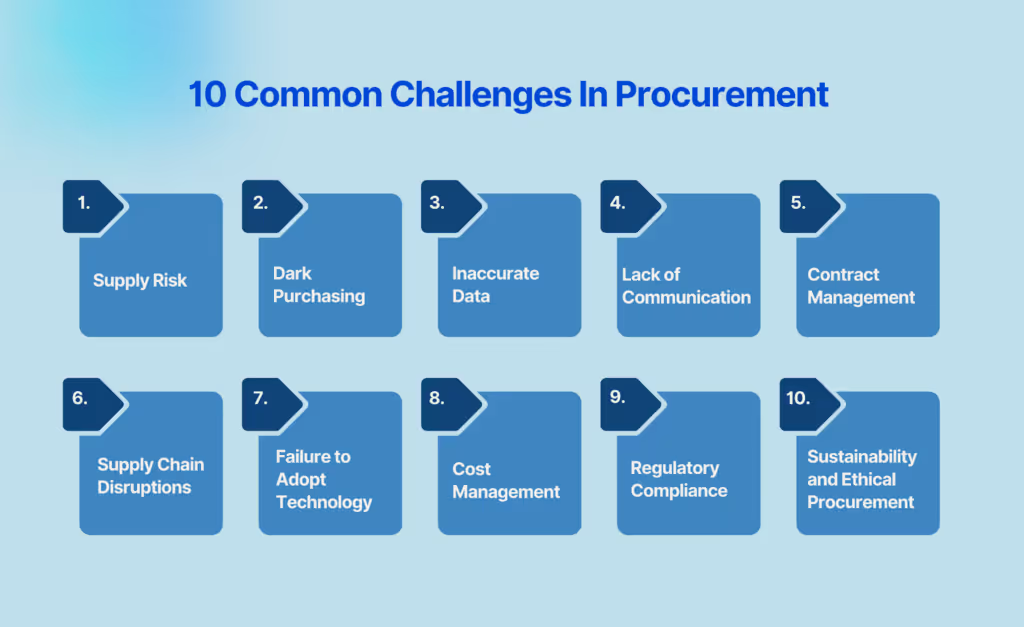
Procurement is a complex process with several challenges that can disrupt operations and impact organizational efficiency.
Below is an overview of key procurement challenges and insights into their implications:
- Supply Risk
Supply risk is one of the most pressing concerns in procurement. It encompasses issues like supplier insolvency, geopolitical disruptions, and unpredictable events such as natural disasters or pandemics. These risks can lead to supply shortages, increased costs, and operational delays.
- Dark Purchasing
Dark purchasing refers to unauthorized or unapproved purchases made outside established procurement processes. This challenge often leads to increased costs, compliance issues, and inefficiencies due to a lack of visibility into spending patterns.
- Inaccurate Data
Accurate data is vital for effective procurement decisions. Procurement challenges and solutions such as siloed systems, outdated records, and manual data entry errors often lead to inefficiencies and poor decision-making.
- Lack of Internal Communication
Poor communication across departments can lead to misaligned goals, unclear requirements, and delays in procurement processes. Effective collaboration is critical to ensure procurement aligns with organizational objectives.
- Contract Management
Managing contracts effectively can be a significant challenge, especially when dealing with multiple suppliers. Common issues include unclear terms, missed deadlines, and the inability to track contract compliance.
- Supply Chain Disruptions
Disruptions in the supply chain—caused by factors such as natural disasters, political instability, or transportation issues—can severely impact procurement timelines and costs. Building resilience and diversifying suppliers are essential strategies for mitigating these risks.
- Failure to Adopt Technology
In today’s digital age, the inability to use procurement technology can hinder efficiency and transparency. Resistance to change, lack of training, and high implementation costs are common barriers.
- Cost Management
Striking a balance between cost savings and maintaining quality is a persistent challenge. Inefficient cost management can erode profitability and affect supplier relationships.
- Regulatory Compliance
Procurement must navigate an increasingly complex regulatory environment, including local and international trade laws. Non-compliance can result in financial penalties and damage to reputation.
10. Sustainability and Ethical Procurement
With a growing emphasis on sustainability, organizations face challenges in sourcing environmentally friendly materials and ensuring suppliers adhere to ethical labor practices. Balancing these goals with cost efficiency is often difficult.
By going through procurement challenges and solutions strategically, organizations can create a more robust and efficient procurement process.
In the next section we are going to see how to overcome different procurement challenges.
How To Overcome Procurement Challenges?
Dealing with procurement challenges requires a practical approach, smart planning, and making the best use of available tools.
Here’s how you can tackle the most common procurement issues effectively:
1. Handle Supply Risks
- Assess Supplier Risks Regularly: Monitor your suppliers’ reliability by checking their financial stability, location risks, and overall performance.
- Work with Multiple Suppliers: Don’t depend on just one supplier for essential items. Having backups ensures you can continue operations during disruptions.
- Track Your Supply Chain: Use tools or platforms that give you a clear view of where your goods come from and any potential risks.
2. Control Dark Purchasing
- Use a Centralized System: Set up a single platform where all purchases must be approved and tracked to avoid unauthorized buying.
- Monitor Spending Patterns: Review purchase reports regularly to spot unusual or unapproved spending.
- Set Clear Rules: Limit who in your team can make purchases and ensure they follow set guidelines
3. Improve Data Accuracy
- Keep Your Data Clean: Regularly update your records and fix errors to ensure accurate procurement data.
- Use One System: Combine all your procurement records in one system to avoid duplication or missing information.
- Double-check Important Data: Before making decisions, confirm that your data is up-to-date and correct.
4. Strengthen Internal Communication
- Use Collaboration Tools: Use messaging apps or team platforms where everyone involved in procurement can easily communicate and share updates.
- Share Real-Time Updates: Use dashboards or reports that show progress, budgets, and supplier performance so everyone is on the same page.
- Encourage Team Meetings: Regular team discussions ensure better understanding and smoother processes.
5. Manage Contracts Effectively
- Track Contract Deadlines: Use reminders or tools to keep up with contract renewals and expiration dates.
- Use Standard Templates: Have ready-made contract templates to avoid confusion or mistakes.
- Review Contracts Regularly: Always check your agreements with suppliers to ensure they’re still meeting your needs.
6. Prepare for Supply Chain Disruptions
- Plan for Emergencies: Create backup plans for delays or shortages, including having alternate suppliers ready.
- Monitor Supply Chain Changes: Monitor weather, political events, or other factors that might affect your supplies.
- Work Closely with Suppliers: Build strong relationships with your suppliers so they’ll prioritize you during disruptions.
7. Embrace New Technology
- Train Your Team: Teach your team how to use new tools so they feel confident and can work efficiently.
- Start Small: Introduce one tool or feature at a time to avoid overwhelming your team.
- Choose Simple Tools: Use systems that are easy to understand and fit your team’s needs.
8. Manage Costs Smartly
- Look at Total Costs: Don’t just focus on the price; consider other costs like delivery, maintenance, or storage when making decisions.
- Negotiate Discounts: Work with suppliers to get better rates, especially for long-term agreements or bulk orders.
- Automate Billing: Use tools to match invoices with orders automatically so you only pay for what you’ve received.
9. Stay Compliant with Rules
- Know the Rules: Stay updated on local and international laws related to procurement.
- Use Compliance Tools: Use tools that check your purchases against regulations and flag issues before they become problems.
- Conduct Regular Audits: Review your processes to ensure you follow all required rules.
10. Support Sustainable and Ethical Procurement
- Work with Responsible Suppliers: Choose suppliers who follow ethical practices and care for the environment.
- Choose Recycled Products: Include recycled or eco-friendly materials in your procurement whenever possible.
- Track Your Impact: Use simple tools to monitor your company’s environmental and social impact in the supply chain.
Following these steps simplifies your procurement process, avoids common problems, and ensures that your operations run smoothly.
How akirolabs Help With Common Procurement Challenges?
At akirolabs, we understand the hurdles you face in procurement. With nearly a century of combined firsthand industry expertise, we have seen these challenges up close. That’s why we designed our platform to simplify your workflows, enhance visibility, and empower you to make smarter, data-driven decisions that drive measurable results.
Here’s how we help you tackle common procurement challenges:
- Streamline Your Processes: Forget outdated spreadsheets and fragmented tools. Our platform centralizes all procurement activities, reducing inefficiencies and manual errors.
- Gain Real-Time Visibility: Get a clear overview of your cost drivers, budget planning and spending patterns with advanced analytics and dashboards.
- Manage Supplier Risks Effectively: Use our robust tools to evaluate supplier reliability, assess buying power dynamics, and strengthen negotiation leverage, ensuring your supply chain remains resilient.
- Collaborate Seamlessly: Collaborative features, efficient accessibility, and intuitive workflows ensure seamless stakeholder alignment, making it a central repository while eliminating ineffective communication streams.
- Optimize Contract Management: Track contract renewals with clear oversight of ownership and business unit allocation, streamlining strategy execution. Ensure transparency for negotiations and reduce risks across your organization.
- Make Data-Driven Decisions: Leverage our AI-powered analytics to benchmark performance, identify trends, and choose the best strategies for your goals.
- Scale Effortlessly: Whether you’re growing operations or expanding globally, our platform adapts to your needs without compromising consistency.
- Deliver Value Beyond Cost Savings: Focus on sustainability, supplier diversity, and innovation while meeting your financial targets.
With akirolabs, you can move from reactive problem-solving to proactive strategic planning, ensuring your procurement drives efficiency, cost savings, and long-term business success.
Conclusion
Procurement is a critical function that, when optimized, can drive significant value and efficiency for any organization. However, the journey is often fraught with supply risks, data inaccuracies, communication gaps, and resistance to adopting technology.
By understanding these common obstacles and implementing proactive strategies—like using technology, improving internal communication, and building resilient supplier relationships—you can transform procurement from a reactive process into a strategic powerhouse. Addressing these challenges streamlines operations and positions your organization for long-term success.
Ready to tackle your procurement challenges head-on? Discover how strategic solutions, cutting-edge technology, and enhanced collaboration can streamline your processes and drive long-term success.
Book a demo today to see how we can help transform your procurement strategy into a competitive advantage!

Guide to Identifying Procurement Categories and Types
Master procurement categories list for strategic efficiency. Understand roles, manage suppliers, and boost success. Start optimizing now!

Procurement is the backbone of your organization’s success. But managing it effectively can feel like an uphill battle. Without understanding a procurement categories list, you may face many problems. You might have inefficiencies, higher costs, and missed opportunities. Does this sound familiar?
Well-defined procurement categories offer great value. They save time, reduce risks, and also boost your bottom line. But where should you begin?
This guide will show you how to identify a procurement categories list. You’ll learn about their types and how to create strategies that deliver results.
What are Procurement Categories?
Procurement categories are groups of goods or services that share similar traits. They help you organize and streamline your procurement process. Think of them as a clear procurement categories list. This list helps you group similar purchases.
For example, you could create a category for office supplies. You could also make another category for IT services.
Defining procurement categories provides a structured approach to procurement management, replacing the chaos of unorganized processes. This structure offers several key benefits:
- Enhanced Operational Efficiency: A well-structured procurement system streamlines operations.
- Informed Decision-Making: Clear categories provide better visibility into spending patterns.
- Improved Procurement Strategies: Organized categories allow for targeted strategies, optimizing supplier relationships and cost management.
- Smarter Purchase Management: Proper organization helps identify areas for cost savings and improve overall procurement efficiency.
Establishing procurement categories allows you to transform your purchasing processes into a more effective and efficient system.
Now that we know about procurement categories, let us see why it is necessary.
Why Use Procurement Categories?

procurement into distinct categories is not merely about maintaining order; it Organizing is a strategic initiative. This approach enhances decision-making capabilities and drives superior outcomes in procurement management.
Grouping your purchases into clear categories has many benefits. It creates structure, streamlines processes, and also unlocks new growth opportunities.
Here’s why procurement categories are essential for your business.
1. Control Costs More Effectively
Effective cost management is a cornerstone of successful procurement, and organizing purchases into categories can dramatically enhance this process. With clear visibility into your spending, you can easily spot inefficiencies, identify cost-saving opportunities, and make smarter financial decisions.
How does this work?
- Bulk Purchasing for Better Deals: Grouping similar purchases across departments allows you to negotiate volume discounts and secure more favorable supplier terms.
- Streamlined Spending: You can reallocate resources to areas that drive innovation or growth by eliminating overlaps and unnecessary expenditures.
- Budget Optimization: A structured approach ensures that every dollar spent delivers maximum value without compromising quality or efficiency.
Imagine reducing waste and channeling those savings into strategic initiatives like technology upgrades or sustainability programs. Category management makes this vision a reality by enabling cost-effective procurement decisions.
2. Manage Suppliers with Ease
Strong supplier relationships are at the heart of efficient procurement operations. Managing suppliers becomes a much more streamlined process when procurement categories are clearly defined. Categorization helps you identify key suppliers, assess their contributions, and foster mutually beneficial partnerships.
Why does this matter?
- Focused Supplier Management: Clear categories allow you to assign suppliers to specific segments, making it easier to manage contracts, assess performance, and address issues.
- Enhanced Collaboration: Building strong relationships with suppliers opens the door to tailored solutions, faster issue resolution, and even co-innovation opportunities.
- Improved Outcomes: Suppliers who feel valued and aligned with your strategic goals are more likely to deliver superior service and meet your expectations consistently.
By prioritizing communication and collaboration with your suppliers, you ensure reliable deliveries, maintain quality standards, and create a resilient supply chain. This not only strengthens your procurement process but also boosts overall business performance.
3. Make Data-Driven Decisions
In today’s data-driven world, information is a powerful tool, but only if it’s organized and actionable. Procurement categories provide a framework for gathering and analyzing data, giving you the insights to make informed, strategic decisions.
How does data-driven decision-making benefit you?
- Identifying Opportunities: Analysis of spending patterns can reveal areas where consolidation of suppliers or renegotiation of contracts could result in significant savings.
- Proactive Planning: Data allows you to anticipate potential challenges, such as rising costs or changing supplier conditions, and respond before they become problems.
- Enhanced Efficiency: With clear insights, you can optimize procurement processes to align with organizational objectives, such as cost control or innovation.
When you use data effectively, procurement decisions become less reactive and more strategic, ensuring that every action contributes to long-term success.
4. Reduce Risks
Procurement is inherently risky; supplier failures, price volatility, and market disruptions can all impact your operations. A well-structured approach to procurement helps you identify and mitigate these risks before they escalate.
How does category management help reduce risks?
- Visibility into Vulnerabilities: Categorizing spending provides a clear view of potential risks, such as over-reliance on a single supplier or exposure to volatile markets.
- Strategic Risk Mitigation: Diversifying your supplier base and negotiating flexible contracts ensure that disruptions, whether from supply shortages or price fluctuations, won’t derail your operations.
- Resilience and Continuity: By planning for potential disruptions, you create a procurement process that is agile and capable of weathering unexpected challenges.
Risk management is not just about avoiding problems; it’s about building a procurement strategy that ensures stability and resilience, even in uncertain times.
5. Align Procurement with Business Goals
Procurement is no longer just about buying goods and services; it’s a strategic function that drives organizational objectives. When procurement categories align with business goals, the impact extends beyond cost savings.
What can this alignment achieve?
- Sustainability Goals: You can focus on sourcing eco-friendly materials and working with ethical suppliers to support your organization’s sustainability initiatives.
- Innovation and Growth: By partnering with suppliers and prioritizing innovation, you can bring cutting-edge solutions into your operations, driving competitive advantage.
- Strategic Value Creation: Procurement categories allow you to align your spending decisions with broader objectives, such as market expansion or operational excellence.
For example, a business prioritizing sustainability can use category management to source from green-certified suppliers, reducing environmental impact while meeting consumer and investor expectations. Similarly, a focus on innovation might drive partnerships with suppliers offering advanced technologies.
In the next section, we are going to take a look at the different types of procurement categories.
Different Types of Procurement Categories
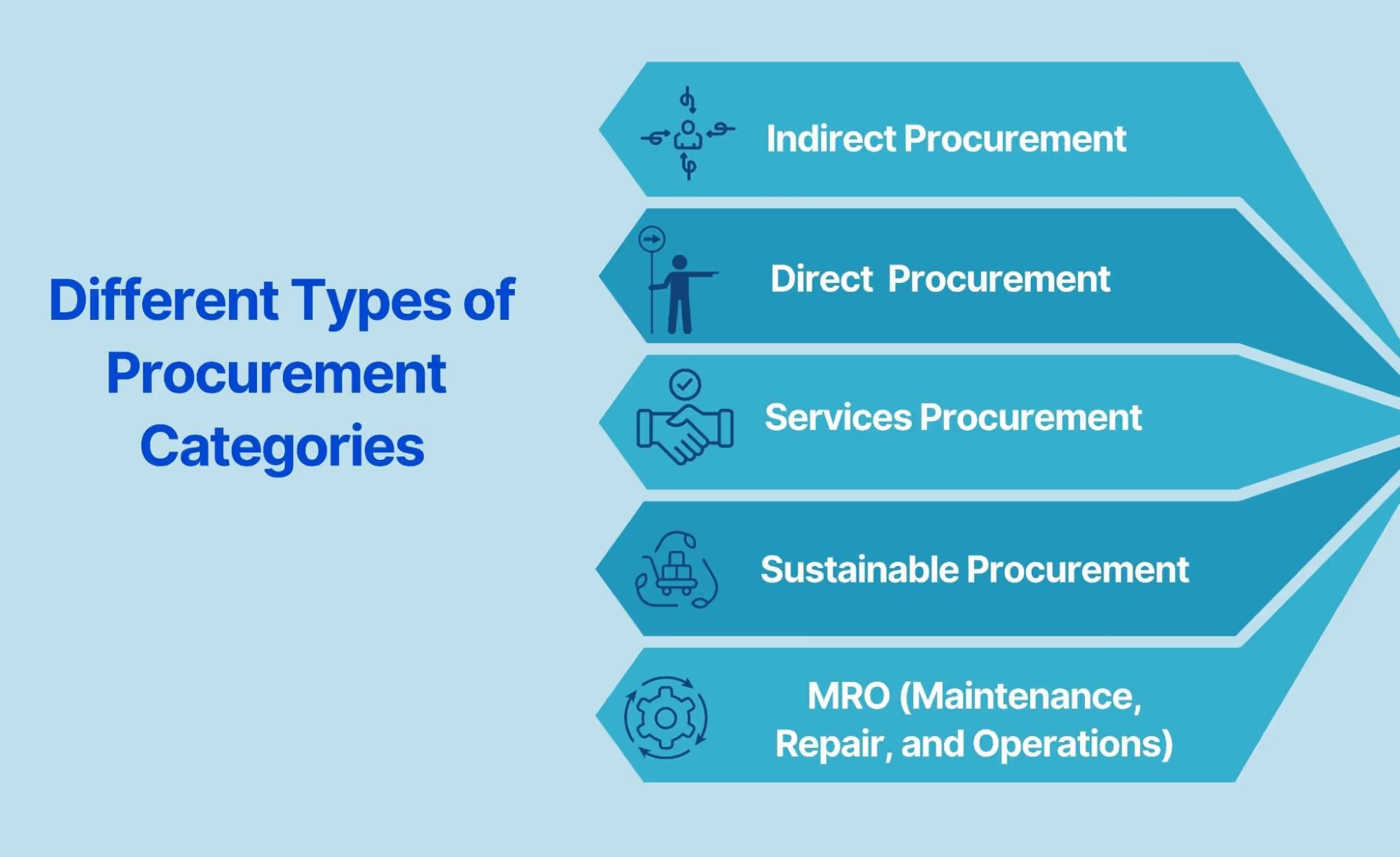
Procurement categories can be divided based on the purpose of the items you procure. You can also group them by the nature of the items.
These categories offer a structured approach to managing purchases. They help ensure your procurement process aligns with your business needs. They also support your overall goals.
Below are the main types of procurement categories. Each is explained in detail.
1. Direct Procurement
Direct procurement involves goods or services contributing directly to your final product. These are critical to your core operations. These items are essential for your core business operations. They directly impact the quality of what you deliver to customers.
- Examples: For a car manufacturer, this might include raw materials. Examples are steel, tires, or engines. In a service-based business, it could include tools or software. These might be essential for service delivery, such as development platforms for IT companies.
Direct procurement requires precise planning. It also depends on reliable supplier relationships. Disruptions in this category can have serious effects. They can impact your production timelines and harm customer satisfaction.
2. Indirect Procurement
Indirect procurement supports your business operations. These purchases don’t contribute directly to your final product. While they don’t generate revenue, these items are essential for running your organization efficiently.
- Examples: Office supplies, marketing services, facility maintenance, or employee training programs.
Managing indirect procurement efficiently can help you control operational costs and improve productivity. Though often overlooked, this category is vital in ensuring smooth business operations.
3. Services Procurement
Services procurement focuses on acquiring external expertise. It also involves obtaining support to meet specific business needs. These services can be project-based. They can also be ongoing. They are often essential for activities outside your core competencies.
- Examples: Hiring IT consultants to upgrade your cybersecurity systems. They can help upgrade your cybersecurity systems. Another example is engaging a legal firm. This is useful for handling compliance matters. You can also use temporary staffing agencies. They can help address short-term workforce shortages.
Effective management of this category ensures you get the right services. It helps you access them at the right time. This approach optimizes both cost and quality. At the same time, it helps maintain flexibility.
4. Services Procurement
Capital expenditures include investments in long-term assets that support your business’s growth and operations. These are typically high-value, one-time purchases that require careful planning and budgeting.
- Examples: Buying machinery for a factory, purchasing real estate for office expansion, or implementing advanced procurement software solutions.
CapEx decisions have a lasting impact on your organization’s financial performance. They also affect operational performance. Because of this, CapEx decisions must align with long-term business strategies.
5. MRO (Maintenance, Repair, and Operations)
MRO procurement focuses on items and services needed to maintain and repair your company’s facilities, equipment, and operations. These items ensure the smooth functioning of your business and help avoid disruptions.
- Examples: Spare parts for machinery, cleaning supplies for offices, or tools for facility maintenance teams.
While MRO purchases may seem minor, their consistent availability is crucial to avoid costly downtime and maintain operational efficiency.
6. Sustainable Procurement
Sustainable procurement is a growing category. It focuses on goods and services that meet ESG standards. ESG stands for environmental, social, and governance standards.
Businesses using this approach aim to reduce their environmental impact. They also strive to support ethical practices.
- Examples: Sourcing biodegradable packaging materials, partnering with suppliers that use renewable energy, or working with fair-trade certified vendors.
This category is becoming increasingly important. Organizations are striving to meet sustainability goals. They also aim to enhance their brand image. Additionally, they work to align with consumer expectations for socially responsible practices.
A structured procurement categories list helps you analyze spending. It also helps you improve supplier relationships. Additionally, it allows you to mitigate risks.
The right tools can simplify this process. AI-driven platforms like akirolabs are a great example. They help make your procurement strategy effective and future-proof.
Let us walk you through the steps to identify procurement categories and their types.
Steps to Identify Procurement Categories and Types
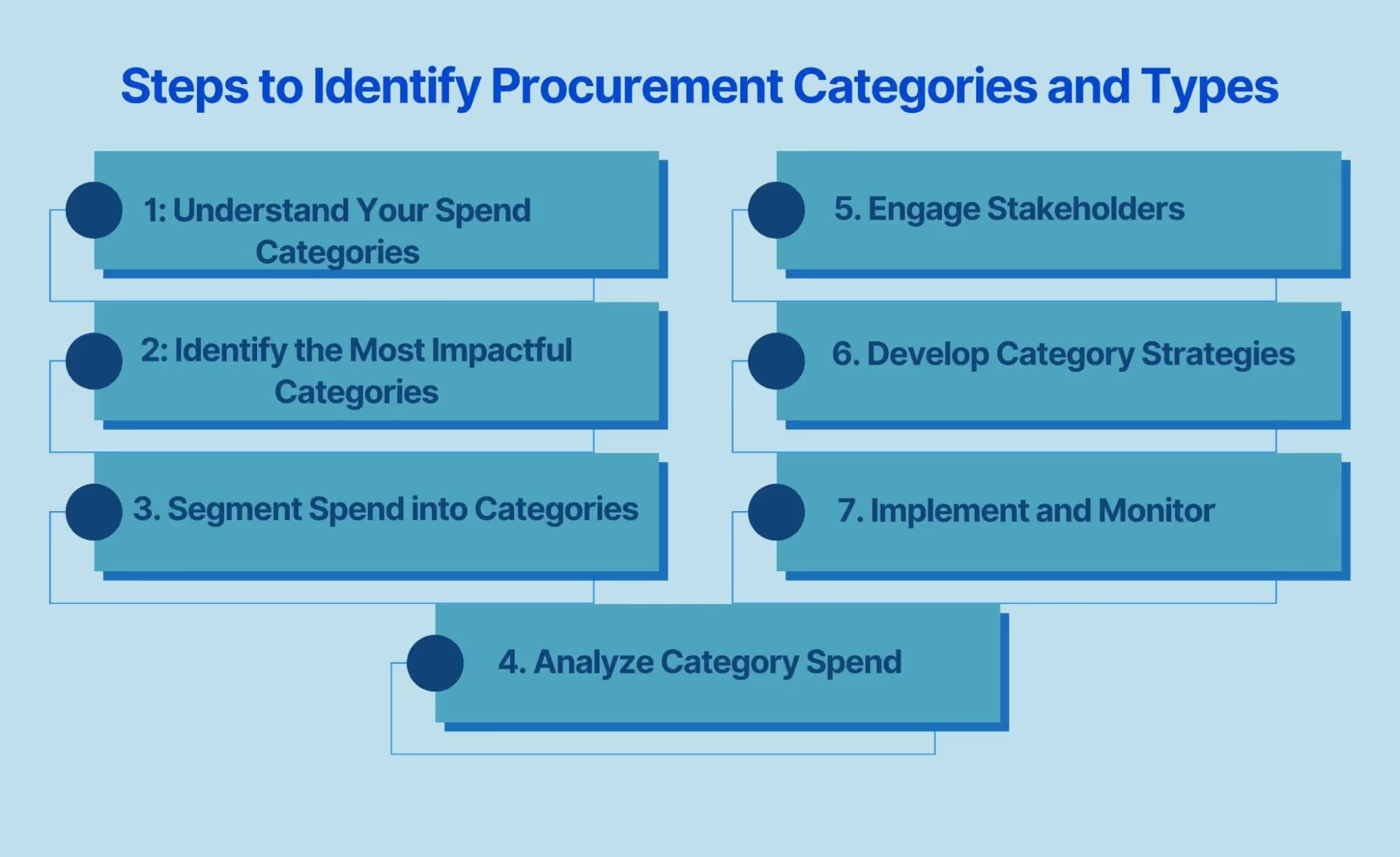
Identifying procurement categories is key to making your purchasing process more efficient and aligned with your business goals. Follow these steps to categorize procurement activities effectively. This ensures your efforts drive value for your organization.
1. Understand Your Spend Categories
Effective procurement category management begins with a clear understanding of your spend categories. This process shifts the focus of procurement teams from generic tasks to driving value in specific business areas. However, you need a comprehensive list before you can influence these categories.
Failing to account for even a single category risks leaving significant spending areas unmanaged and unsupervised. To thoroughly inventory your categories, consolidate and organize all spend data into a procurement spend taxonomy. A taxonomy is a hierarchical breakdown of expenditures, categorized by what the business purchases rather than who makes the purchase.
This distinction is crucial, as it provides clarity and focus. While sorting spend data into a taxonomy can seem daunting, advancements in AI and spend analytics tools have made the process significantly more efficient. Implementing these technologies ensures accurate categorization and establishes a foundation for impactful category management.
2. Identify the Most Impactful Categories
Managing all categories is feasible for larger procurement organizations with dedicated category teams. However, smaller teams may need to prioritize a few high-impact categories to drive meaningful results. This step involves evaluating which areas of the business warrant the most attention.
Consider the following questions:
- Which categories are critical to business operations?
- Where is the majority of our spending concentrated?
- Are there any visible, large-scale challenges?
- What are the expectations of Finance or the board for this year?
By focusing on categories with the greatest potential for impact, you shift your efforts from administrative tasks to strategic value creation. Going deeper into a few categories rather than spreading your resources thin allows for a more profound and measurable impact on your organization.
3. Segment Spend into Categories
Group similar goods and services into distinct categories. Organize them based on their function or purpose. For example, office supplies can be one category. IT services can form another. Marketing materials can be a third category. This step helps you understand your spending patterns. It also highlights areas where you can improve efficiency.
4. Analyze Category Spend
Take a close look at the spending within each category. Identify trends, areas with high costs, and potential savings opportunities. This analysis reveals where your procurement team should focus its efforts to maximize value. For instance, you may find opportunities to negotiate better deals with suppliers or consolidate purchases across departments.
5. Engage Stakeholders
Work with key stakeholders across your organization to validate your categories. This collaboration ensures the categories reflect the actual needs of the business. For example, IT, operations, and marketing team leads can provide valuable insights. They can share details about their specific procurement requirements. This input makes your categories more accurate. It also makes them more effective.
6. Develop Category Strategies
Based on your analysis, create a specific strategy for each category. These strategies should align with your business goals. They should address key areas such as cost optimization, supplier relationships, and risk management. For example, you might reduce supplier dependencies in one category. In another category, you could prioritize cost savings.
7. Implement and Monitor
Put your category strategies into action and track their performance over time. Use key performance indicators (KPIs) to measure success and identify areas for improvement. Regular monitoring ensures your strategies stay relevant and deliver results as your business evolves.
These steps help you create a clear procurement categories list. This list will effectively support your organization’s needs.
A well-structured approach brings many benefits. It helps you save time and cut costs. It also creates value for your business.
Using tools like procurement software makes the process even more efficient. These tools provide insights to help optimize your procurement strategy. Let’s see how we can analyze procurement categories.
Analyzing Procurement Categories
Once you’ve defined your procurement categories, analyzing them is the next critical step. This analysis ensures that each category adds value to your organization and aligns with your business goals.
Here’s how you can effectively evaluate your procurement categories:
1. Spend Analysis
Understanding your spending habits is the foundation of smart procurement. Dive deep into each category and analyze where your money is going. Look for patterns, trends, and any red flags that stand out. For example, you might discover that a specific category is consistently over budget or notice items being purchased more frequently than necessary.
This analysis isn’t just about spotting inefficiencies—it’s about uncovering opportunities to make your spending work harder for you. Ask yourself:
- Are there items we could purchase in bulk to get better pricing?
- Are there unnecessary purchases we can eliminate?
By identifying these areas, you can make informed decisions, cut costs, and allocate your budget more effectively. It’s about working smarter, not harder, with your resources.
2. Supplier Evaluation
Your suppliers are the backbone of your procurement process, so it’s crucial to evaluate them regularly. This means looking at factors like pricing, quality of goods or services, delivery timelines, and responsiveness. A supplier consistently delivering late or providing subpar quality can disrupt your operations and impact your bottom line. On the other hand, high-performing suppliers who meet or exceed expectations could be given more business.
Consider these key questions:
- Are our suppliers meeting the quality and timeline standards we need?
- Can we consolidate suppliers to reduce costs and improve efficiency?
Evaluating your supplier base helps you strengthen your supply chain, build better relationships, and ensure you get the best value for your money. Think of it as a partnership; when your suppliers succeed, so does your organization.
3. Market Intelligence
In today’s fast-changing world, staying ahead of market trends is not optional; it’s essential. Keeping an eye on market dynamics allows you to anticipate potential risks and adjust your procurement strategy accordingly. Tools and resources can help you track key data, such as pricing fluctuations, supply chain disruptions, and emerging industry trends.
For example, if raw material prices rise, you might need to renegotiate contracts or explore alternative suppliers to maintain profitability. Ask yourself:
- Are there new suppliers or innovations in the market that could benefit us?
- Do external factors, like economic shifts or regulatory changes, impact our procurement categories?
By staying informed, you can proactively adapt your strategies, keeping your procurement process efficient and competitive. Market intelligence is like having a GPS for your procurement journey, and it ensures you’re always heading in the right direction.
Each step, spend analysis, supplier evaluation, and market intelligence, provides insights to optimize your procurement categories. Together, they help you:
- Identify cost-saving opportunities.
- Strengthen supplier relationships.
- Stay ahead of market changes and risks.
The key is to continuously evaluate and refine your approach. Procurement isn’t a set-it-and-forget-it process; it’s dynamic and ever-evolving. By keeping your strategies agile, you create a procurement process that’s not just cost-effective but also value-driven.
Developing Category Management Strategies
Developing robust category management strategies is a cornerstone of effective procurement. These strategies optimize the procurement process and ensure alignment with your organization’s broader goals. A well-structured approach brings immense value by maximizing procurement outcomes, minimizing risks, and improving efficiency.
Follow these steps to create impactful category management strategies:
1. Engage Key Stakeholders
Involving the right stakeholders early in the process ensures that your strategies are relevant and aligned with organizational goals. Key contributors, such as department heads, procurement teams, and finance leaders, can offer valuable insights and address specific needs within their areas of expertise.
Stakeholder engagement also fosters collaboration, builds consensus, and reduces conflicts during implementation.
How do we engage stakeholders effectively?
- Organize collaborative meetings to discuss goals, priorities, and potential challenges.
- Encourage open dialogue to gather diverse perspectives.
- Demonstrate how the strategies will benefit each department and the organization.
By involving stakeholders in the planning process, you gain their support and create more practical and impactful strategies.
2. Conduct Comprehensive Market Research
Market research is essential for understanding the external factors influencing each procurement category. It provides critical insights into supplier capabilities, pricing trends, industry standards, and emerging technologies.
Why is this important?
Thorough market research helps you:
- Identify opportunities for cost savings and quality improvements.
- Anticipate and mitigate risks.
- Stay competitive by adapting to industry changes and technological advancements.
Best practices for effective market research
- Use reliable sources such as industry reports, supplier data, and analytics tools.
- Focus on trends that directly impact your organization’s procurement categories.
Armed with these insights, you can create relevant and forward-thinking strategies.
3. Develop Tailored Category Strategies
Once you’ve gathered the necessary data, use it to create customized strategies for each procurement category. These strategies should be specific, goal-oriented, and designed to address each category's unique challenges and opportunities.
Examples of tailored strategies include
- Negotiating supplier contracts to achieve cost savings.
- Setting clear performance expectations to ensure quality.
- Exploring partnerships to incorporate innovative technologies.
Tailored strategies are more likely to deliver measurable value and align seamlessly with your business objectives. They also help target specific outcomes, such as reducing costs, improving supplier performance, minimizing risks, and fostering innovation.
4. Implement and Monitor
After finalizing your strategies, the next step is to implement them. Implementation requires a structured approach with clear plans, timelines, and accountability.
Key steps for successful implementation
- Create detailed action plans that outline responsibilities and deadlines.
- Set measurable goals and define key performance indicators (KPIs) to track progress.
Monitoring is equally important to ensure the strategies remain effective. Regularly review performance metrics such as cost savings, supplier performance, and risk mitigation.
How to stay on track
- Use data-driven insights to analyze issues if a strategy isn’t meeting expectations.
- Engage stakeholders in problem-solving discussions and make necessary adjustments.
- Continuously update strategies to reflect changing business needs and market conditions.
5. Continuous Improvement
Category management isn’t a one-time task. It’s an ongoing process that requires regular evaluation and refinement. By keeping your strategies dynamic and adaptable, you can ensure long-term success and alignment with your organization’s goals.
How Can akirolabs Help You Optimize Your Procurement Process?
If managing your procurement process feels overwhelming, akirolabs can change that. This AI-powered platform is built to simplify your procurement efforts, make collaboration seamless, and give you the insights you need to make smarter, faster decisions. Here's how akirolabs can help you take control and transform your procurement strategy:
1. Collaborate in One Central Hub
With akirolabs, you can centralize all plan-to-strategy processes for your strategic procurement and category management needs. Say goodbye to scattered spreadsheets and endless email threads.
- Stay Aligned: Collaboration means involving all relevant stakeholders—whether internal or external—right from the start. By inviting them to be part of the strategy-building process, you ensure early buy-in and make it easier to gather business requirements. Everyone has access to the strategies being developed, fostering seamless teamwork and alignment from day one.
- Tranparency and Complient: The platform makes it easy to trace decisions, ensuring transparency and compliance. With built-in audit-friendly features, you can reliably track who made what decision, making the entire process clear, accountable, and easy to review.
2. Access to Spend Data
No more moving between fragmented tools or endless spreadsheets. akirolabs integrates seamlessly with your preferred spend analytics tool, allowing you to access and leverage spend data in one centralized place.
- Flexible Data Integration: Ingest data through uploads or direct integrations with a frame-in-frame view that mirrors your existing spend analytics tool.
- Centralized Insights: Consolidate all your spend data, making it easier to create effective category strategies without switching between multiple platforms.
3. Build Supplier Strategies
If you want to improve the way you work with suppliers, akirolabs makes it easy. You can create clear supplier strategies, track progress, and make smarter decisions that add value to your business.
- Create Supplier Strategies: Develop plans to work with the right suppliers who meet your goals.
- Strengthen Your Business: Build strong supplier partnerships by inviting them to be an extended part of your strategy.
4. Proactively Reduce Risks
Procurement teams often find themselves reacting to disruptions, but akirolabs helps you stay ahead of the curve. With scenario modeling capabilities, you can plan for potential risks and future-proof your operations.
- Plan Ahead: Build and analyze multiple scenarios to prepare for global issues like supplier disruptions, price volatility, or market changes, ensuring your business is ready for any challenges.
- Stay Prepared: Move beyond firefighting by creating contingency strategies that keep operations running smoothly, even in unpredictable situations.
5. Track and Achieve Goals
If you want to focus on creating measurable value for your business, akirolabs is here to help. You can track progress of your initiatives, measure results, and make sure your procurement strategy supports your business and sustainability goals.
- Keep Track of Your Initiatives: Use easy tools to see what’s working and where you’re making the most impact.
- Measure Your Progress: Use simple reports to show how well you’re reaching your goals.
- Build a Stronger Brand: Show department heads and board that you care about business and bottom line.
6. Create Strategies That Fit Your Business
You know every procurement category is unique, and akirolabs gives you the tools to develop tailored strategies for each one. It’s all about focusing on your goals and what works best for you.
- Adapt Your Plans: Build strategies that evolve as your business needs and market conditions change.
- Set KPIs That Matter: Track the metrics that align with your goals and adjust as needed.
- Unlock the value dimensions that are most important for your business: Use data insights to find the right levers to maximize business value.
Conclusion
Identifying and managing procurement categories is a strategic move that can transform your procurement process. By grouping purchases into clear categories and analyzing them effectively, you can control costs, reduce risks, and align procurement with your business goals.
If you’re ready to enhance your strategy, platforms like akirolabs can help. These tools streamline category management, offer AI-driven insights, and promote collaboration in one centralized platform.
Don’t wait to optimize your procurement process. Request a demo today and discover how akirolabs can drive efficiency and value for your organization.

The Complete Guide to Understanding the 4 Procurement Maturity Levels
Understand and assess your organisation's procurement maturity level. Find insights to boost procurement maturity and drive higher business value.

In today's rapidly evolving business landscape, procurement has emerged as a critical function that can significantly impact an organization's success. As global events reshape supply chains and business priorities shift, the role of procurement has transformed from a mere support function to a strategic partner driving value creation. Understanding the different levels of procurement maturity is crucial for organizations aiming to optimize their operations and gain a competitive edge.
The Importance of Procurement in Modern Business
Procurement's role has expanded beyond traditional transaction processing and supplier management. Today, it is a vital component of business strategy, innovation, and sustainability. Organizations excelling in procurement maturity are better positioned to navigate market fluctuations, mitigate risks, and capitalize on opportunities. Optimizing procurement practices allows companies to achieve cost efficiencies, enhance supplier relationships, and support overall business objectives.
Understanding Procurement Maturity Levels
Procurement maturity levels provide a framework for assessing the effectiveness and strategic alignment of an organization's procurement function. These levels range from basic operational activities to advanced strategic initiatives that drive multi-dimensional value. Let’s delve into each level and understand their unique characteristics and impact on organizational performance.
From Operational to Strategic
Advancing from an operational role to a strategic business partner involves several stages. Each level of maturity reflects an increased integration of procurement with broader business goals and a greater emphasis on value creation. This journey is marked by transitioning from essential transaction management to advanced strategic initiatives encompassing innovation, sustainability, and cross-functional collaboration.
Level 1: Support Function Focus (Operational P2P)
At the foundational level, procurement primarily focuses on the fundamental aspects of the purchase-to-pay (P2P) cycle. The main objectives are ensuring that suitable materials are available at the right time, minimizing costs through essential negotiation, and managing transactional activities such as requisitioning, ordering, and payment processing.
The Basics of Purchase-to-Pay (P2P) Cycle
The P2P cycle is the core of operational procurement. It often involves requisitioning materials, placing orders, receiving goods, and processing payments. This level ensures the necessary materials are available for production and operations, maintaining business continuity.
Key Objectives and Activities
At this stage, procurement aims to:
- Ensure timely availability of materials
- Minimize costs through essential negotiation
- Manage transactional activities efficiently
- Ensure compliance with procurement policies
Challenges and Limitations
Procurement at this level is mainly reactive and administrative. The focus is on compliance and managing supplier performance rather than contributing to strategic business planning. The activities are essential for maintaining smooth operations but lack the strategic impact required to drive significant business value.
Level 2: Cost Cutter Focus (Tactical S2C)
As organizations recognize the potential of procurement to drive cost savings, they move to a more tactical approach. At this level, procurement activities become more structured, incorporating strategic sourcing initiatives, basic supplier management practices, and short-term cost-cutting measures.
Strategic Sourcing Initiatives
Strategic sourcing involves systematically evaluating and selecting suppliers for long-term cost savings and supply stability. This includes conducting market analysis, negotiating contracts, and leveraging economies of scale. For more insights on strategic sourcing, you can refer to the CIPS Guide to Strategic Sourcing
Supplier Management Practices
Effective supplier management practices at this level include regular performance reviews, supplier audits, and the development of long-term supplier relationships. These practices help ensure suppliers meet the organization's quality and delivery standards. Learn more about supplier relationship management
Short-term Cost-Cutting Measures
At this stage, the primary focus is achieving immediate cost reductions through competitive bidding, contract renegotiation, and volume discounts. While these measures deliver tangible benefits, they often remain isolated from broader business functions
Level 3: Strategic Sourcing - Siloed Power Game & Category Management Focus
At this level, procurement begins to align more closely with business strategies. The focus shifts to managing categories to optimize savings and support long-term organizational goals. However, traditional category management often remains within a siloed framework, leading to several limitations.
Overview of Category Management
Category management involves grouping similar products or services to leverage purchasing power and achieve significant savings. This approach allows procurement teams to develop specialized strategies for different categories, enhancing efficiency and effectiveness. check out why Procurement Leaders think old school category management is no longer effective.
Traditional Frameworks like the Kraljic Matrix
The Kraljic Matrix is a widely used framework in category management. It categorizes products based on supply risk and profit impact, helping procurement teams prioritize sourcing strategies. However, this approach can be overly tactical and fail to account for the unique needs of different business units. Read more about the Kraljic Matrix from CIPS.
Limitations of Siloed Approaches
Despite intentions to support strategic objectives, siloed procurement practices can lead to several challenges:
- Limited collaboration with other business units
- A narrow focus on internal procurement efficiencies
- Inability to fully align with broader business goals
While this level represents a significant improvement over previous stages, it still falls short of accurate strategic alignment.

Level 4: NextGen Strategic Procurement (Truly Strategic)
This is where procurement truly comes into its own as a strategic business partner. At this level, procurement transcends traditional roles to fully align with overarching business objectives. Critical characteristics of NextGen Strategic Procurement include scenario modeling, multi-dimensional value creation, cross-functional collaboration, digital transformation, agility and responsiveness, risk management, and sustainability focus.
Characteristics of NextGen Strategic Procurement
NextGen Strategic Procurement is characterized by a holistic and integrated approach that aligns procurement strategies with overall business goals. It focuses on creating value across multiple dimensions, including cost savings, sustainability, resilience, and innovation.
Scenario Modeling : Scenario modeling provides a comprehensive view of procurement activities, incorporating various business requirements and external factors. This approach allows procurement teams to develop strategies adaptable to changing market conditions and aligned with overall business goals.
Multi-dimensional Value Creation for Business: Procurement at this level focuses on creating value beyond cost savings. This includes enhancing sustainability, driving innovation, and improving supply chain resilience. By adopting a multi-dimensional approach, organizations can achieve more significant long-term benefits.
Cross-functional Collaboration: Early engagement with various departments ensures that procurement strategies are aligned with their needs and objectives. This fosters a unified approach and enhances the strategic impact of procurement activities.
Digital Transformation: Advanced technologies, including AI and machine learning, are leveraged to enhance decision-making, streamline operations, and drive innovation. Digital transformation enables procurement teams to become more agile and responsive to changing market conditions. For more information on digital transformation in procurement, visit Gartner's insights on procurement technology
Agility and Responsiveness: Integrating digital systems helps procurement teams quickly adapt to market fluctuations and evolving business needs. This agility ensures that procurement remains a strategic asset in a dynamic business environment.
Advanced Risk Management: Advanced risk assessment and mitigation strategies are implemented to ensure a resilient supply chain. This includes identifying potential risks, developing contingency plans, and proactively managing supplier relationships. For more on risk management, refer to this whitepaper by Sphera.
Sustainability Focus: Procurement plays a crucial role in driving sustainability initiatives throughout the supply chain. This includes sourcing from environmentally responsible suppliers, reducing waste, and supporting sustainable production practices.
The impact of NextGen Strategic Procurement is significant, with benchmarks indicating potential value generation up to 4.4 times higher than traditional approaches. For further reading on why NextGen is the way forward, check out the ebook "Category Management is Dead: What Comes Next" from us.
Navigating the Path to Procurement Excellence
Regardless of your organization's procurement maturity curve, there's always room for improvement. Here are some critical steps to consider as you work towards achieving NextGen Strategic Procurement:
Assess Your Current State: Conduct a thorough evaluation of your procurement function to understand your maturity level. This involves reviewing existing processes, identifying gaps, and benchmarking against industry standards.
Set Clear Goals: Define what you want to achieve with your procurement function and how it aligns with your business strategy. Setting clear goals provides direction and helps prioritize procurement initiatives.
Invest in Technology: Embrace digital transformation by implementing advanced procurement tools and platforms to streamline processes and provide valuable insights. Technology investment is crucial for enhancing procurement efficiency and effectiveness.
Develop Your Team: Invest in training and development to ensure your procurement team has the skills to operate strategically. This includes developing competencies in strategic processes for procurement, risk management, and sustainability.
Foster Collaboration: Break down silos by encouraging cross-functional collaboration and early stakeholder engagement in procurement decisions. This ensures that procurement strategies are aligned with the needs and objectives of different business units.
Implement Scenario Modeling: Adopt advanced methodologies like scenario modeling to enhance decision-making and strategic alignment. Scenario modeling helps develop adaptable strategies for various business requirements and market conditions.
Focus on Sustainability: Integrate sustainability into your procurement strategies to meet regulatory requirements and stakeholder expectations. Sustainable procurement practices can drive long-term value and support corporate social responsibility goals.
Continuously Improve: Review and refine your procurement strategies regularly to align with evolving business needs and market conditions. Continuous improvement is essential for maintaining procurement excellence and achieving long-term success.
Conclusion: Embracing the Future of Procurement
As we navigate an increasingly complex business environment, procurement's role continues to evolve. Moving beyond traditional cost-cutting measures, NextGen Strategic Procurement can potentially drive significant value creation across multiple dimensions.
Organizations can transform their procurement function into a powerful driver of business success by understanding the different levels of procurement maturity and working towards achieving accurate strategic alignment. Whether you're just starting your journey or looking to take your procurement function to the next level, embracing the principles of NextGen Strategic Procurement can help you stay ahead in today's competitive business landscape.
The journey toward procurement excellence is not about chasing the next framework or digital tool, but about fundamentally rethinking how procurement creates value. As traditional models like the Kraljic Matrix or siloed category management lose relevance, the future belongs to organizations that embrace collaboration, sustainability, and AI-augmented decision-making. At akirolabs, we see this shift every day with our customers. By embedding next-generation methodologies such as strategic scenario modeling, procurement with purpose, and human-AI augmentation, we are helping procurement leaders redefine their role—from cost managers to value architects.
This transformation is not just theoretical; it is happening in practice. Leading enterprises across industries are already leveraging akirolabs to co-create strategies with their stakeholders, align procurement with business priorities, and capture multidimensional value—savings, sustainability, innovation, resilience—at once. The result is a procurement function that is no longer reactive or transactional, but always-on, future-proof, and business-critical.
We believe the next era of procurement is already unfolding—and it requires bold leadership. To illustrate how this vision comes to life, we invite you to watch our short video where we showcase how akirolabs enables procurement teams to move up the maturity curve and deliver 4–5x higher value. The only question is: will you lead this transformation, or follow?
Join a Smarter Procurement Network
Subscribe for expert insights, news, and upcoming
events in procurement.
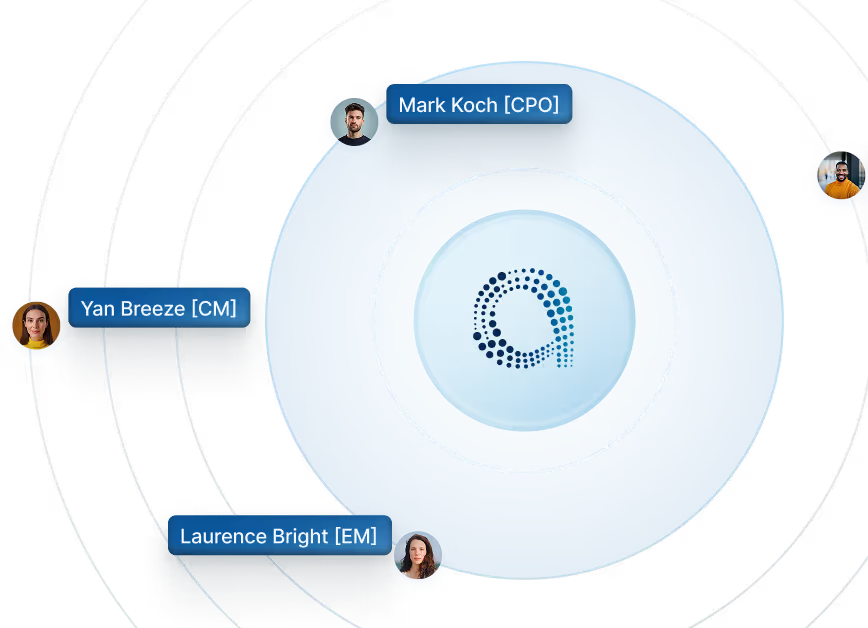
All Blogs
Ready to Transform Your Procurement Strategy?
There’s a better way to do procurement. This is IT.
.avif)